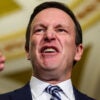The White House has just issued an 11 page concept paper (PDF) for yet another health care bill that, among other items, includes a proposed new Federal “Health Insurance Rate Authority.” The Administration has yet to provide any legislative language on how this new Federal regulatory regime would operate, but based on statements by the President and other officials, as well as similar provisions included in the bills already passed by the House and Senate, there is good reason for concern as to whether the President and Congress really know what they are doing in this regard.
The President and the Congressional leadership assert that health insurer rate increases are unjustified and point to some cases of recent double-digit increases announced by certain insurers. But so far they have offered no explanation of what portion of those increases they think are unjustified or their reasons for taking such a position.
The Daily Signal depends on the support of readers like you. Donate now
In reality, there are a number of reasons why health insurers raise their rates, and so-called “insurer price-gouging” is one of the least likely causes. The biggest reason is growth in the price and volume of medical care that the plans pay for. If policyholders consume more medical care and/or if doctors and hospitals charge higher fees, then insurers must—obviously—raise their premiums to cover the added costs.
Another reason, and one that is particularly relevant this year, is that during recessionary periods some individuals in good health figure that they can save money by temporarily dropping health insurance coverage. They are betting that they will stay healthy and that, once the economy and their personal situation improve, they can buy coverage again. Of course, that means that insurers face a drop in premium income and need to raise rates on their remaining policyholders to cover the difference.
What is most disturbing about the President’s latest proposal, and similar ones in Congress, is the apparent lack of understanding that one of the most basic purposes of insurer financial regulation is not to prevent “price-gouging,” but rather to prevent the problems that occur if insurers under-price their products. Specifically, if an insurer fails to charge enough in premiums to cover its expected claims costs, then it is at risk of being unable to make good on the promises made to its customers. That can leave policyholders with worthless coverage or spark demands for government bailouts that impose on taxpayers the cost of covering the losses.
It was precisely such problems that led states more than a century ago to start regulating insurance. As in any other market, competing insurers try to attract customers by offering lower—not higher—prices (premiums). But “consumer protection” in insurance rate regulation means ensuring that insurers are financially sound enough to make good on the promises made to their customers. Thus, a primary objective of insurance law and regulation is to ensure that insurance companies charge enough in premiums, and set aside enough in reserves, to be able to pay the claims that they have promised to pay.
The whole AIG debacle is a good illustration of what can go wrong if an insurer is allowed to under-price coverage. What AIG essentially did was to sell banks insurance against their loans going bad. But because it structured what were really insurance policies as financing instruments, AIG was able to avoid insurance regulator oversight and instead have the products regulated by banking regulators who weren’t experts in insurance.
The result was that AIG underestimated the size of its potential liabilities, under-priced the coverage (which made banks even more willing to buy it, since the “premiums” were cheap), and failed to set aside sufficient reserves against claims. When the banks’ loans went bad, AIG was faced with tens of billions of dollars in claims that it simply couldn’t pay. Congress had a choice of either telling the banks, “Sorry, you bought worthless insurance,” or sticking the taxpayers with the tab to bailout AIG so that it could payoff the banks’ claims. In the end, Congress, worried about the collapse of the banking sector, stuck taxpayers with the bill and bailed out AIG so that it could pay off the banks.
A President and Congress that want to regulate health insurance rates, but either don’t understand or don’t care about the potential costs and damage of allowing—or even forcing—insures to under-price their coverage, and who seem to have learned nothing from the AIG experience, is something that all Americans should be very worried about.






























